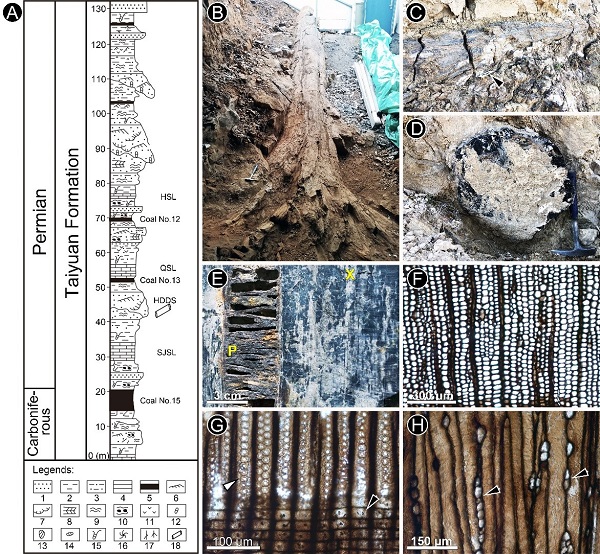Cordaitaleans, as close relatives of modern conifers, had a long geological history in the Cathaysia from the Visean (Mississippian, lower Carboniferous) to the end of Permian. They became prominent since the late Pennsylvanian, and best developed during the Cisuralian (early Permian) in North China, serving as the volumetrically dominant to subdominant elements of wetland floras. Architecture and ecology of the Cathaysian cordaitaleans from non-peat-forming environments are poorly known.
Dr. WANG Mingli and other researchers from Nanjing Institute of Geology and Palaeontology, Chinese Academy of Sciences (NIGPAS), recently found 211 giant cordaitalean trunks and described their morphology and brief anatomical features from the Cisuralian Taiyuan Formation in Yangquan, Shanxi Province, North China. This results have been published online in Palaeoworld. It is reported that the discovery of the giant cordaitalean trunks has attracted great attention from the local government, and has been listed as a key protection object by the Yangquan City Planning and Natural Resources Bureau. It is planned to build a fossil remains park and museum on this basis.
These trunks are characterized by the Artisia-like pith and pycnoxylic xylem. Absence of growth rings in the logs suggests they grew under non-seasonal humid tropical conditions. They are preserved in sandstone bodies interpreted as deposits of distributary river channels on the delta plain. Several trunks with attached rooting systems indicate that these trees may have been growing on channel levees or delta plains and brought into the channels by lateral bank erosion. Allometric estimates of tree height suggests that the largest trees were up to approximately 43.5 m tall. Mature cordaitaleans with straight trunks were probably the tallest trees and formed the canopy of the riparian forest in North China during the Cisuralian.
This study was supported by the Strategic Priority Research Program (B) of the Chinese Academy of Sciences, the National Natural Science Foundation of China, Youth Innovation Promotion Association CAS and the National Science Foundation.
Reference: Wan, M.L., Yang, W., Wan, S., Li, D.D., Zhou, W.M., He, X.Z., Wang, J., 2020. Giant cordaitalean trees in early Permian riparian canopies in North China: Evidence from anatomically preserved trunks in Yangquan, Shanxi Province. Palaeoworld, https://doi.org/10.1016/j.palwor.2020.04.008

Chrono- and lithostratigraphy of the Taiyuan Formation in Yangquan, Qinshui Basin, Shanxi Province, North China(A), in addition to the gross morphology (B-D) and anatomical features (E-H) of the trunks.
Download:
